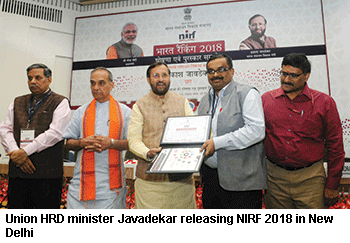 THE THIRD EDITION OF the National Institutional Ranking Framework (NIRF) of the Union human resource development (HRD) ministry which rates and ranks India’s Top 100 higher education institutions ‘overall’ and Top 100 universities, engineering institutes, undergrad colleges, B-schools, pharmacy schools, medical colleges and law schools separately, was released on April 3 in New Delhi with considerable fanfare by Union HRD minister Prakash Javadekar.
THE THIRD EDITION OF the National Institutional Ranking Framework (NIRF) of the Union human resource development (HRD) ministry which rates and ranks India’s Top 100 higher education institutions ‘overall’ and Top 100 universities, engineering institutes, undergrad colleges, B-schools, pharmacy schools, medical colleges and law schools separately, was released on April 3 in New Delhi with considerable fanfare by Union HRD minister Prakash Javadekar.
In the all-important overall category, the Indian Institute of Science (IISc), Bangalore, is ranked India’s #1 higher education institution for the third consecutive year followed by the four IITs of Madras, Bombay, Delhi and Kharagpur and Jawaharlal Nehru University (JNU), New Delhi, which are ranked in the Top 6. Two IITs (Kanpur and Roorkee), Benares Hindu University and Anna University complete the Top 10 table.
In the Top 100 universities league table, JNU is ranked #2 (after IISc, Bangalore) followed by Benares Hindu University (#3), Anna (Chennai) and Hyderabad universities. Curiously, Delhi University which experiences the highest admissions rush every year, is ranked a modest #7 and Mumbai University (estb.1857) isn’t ranked at all.
In the league table of engineering institutes, seven places at the Top 10 table are awarded to Central government-promoted IITs headed by IIT-Madras. But the Birla Institute of Technology & Science, Pilani (estb.1964) — commonly accepted as an equivalent of the IITs, is awarded a lowly rank of #17 — below Anna University, Chennai (#8), IIIT-Hyderabad (#9) and Jadavpur University (12).
Similar anomalies are to be found in the undergrad colleges league table of NIRF 2018. The country’s #1 arts, science and commerce college is Miranda House, Delhi, followed by St. Stephen’s, Delhi and the almost unknown Bishop Heber College, Tiruchirapalli at #3, ahead of the Shri Ram College of Commerce, Delhi (#7) which stipulates a 99 percent cut-off for admission into its commerce stream. The highly fancied St. Xavier’s College, Mumbai, is not ranked at all. Nor are the new genre Ashoka and O.P. Jindal private universities, both in Delhi NCR.
Experienced market research professionals attribute the anomalies, omissions and low credibility of the annual NIRF rankings to flawed methodology. For one, the facts and data (including public perception) are required to be submitted to the HRD ministry by ‘participating’ institutions. On the basis of this data and documentation, the ministry ranks participating institutions in each category. It’s doubtful if the ministry makes any effort to gather data from independent sources to cross-check the submitted information. Even ‘perception details’, including peer, employer and public perception are required to be submitted by participating institutions. Universities, colleges, B-schools etc unwilling or unable to assume the burden of gathering the extensive data solicited are excluded.
The inherent danger of transferring the entire burden of data collection, compilation and submission to participating institutions is tacitly acknowledged by the HRD ministry and authors of NIRF 2018. The following disclaimer is appended to the data sheets submitted by participants and published as a PDF attachment in the NIRF league tables: “Responsibility for the accuracy and authenticity of data files with concerned institution”.
“Comparing the 2017 and 2018 overall rankings, 26 of the Top 100 ranked institutions are new entrants. Among those that have dropped out of the rankings is the country’s foremost business school, the Indian Institute of Management, Ahmedabad, which was ranked #17 overall last year,” says Thomas Manuel, a playwright-journalist writing in the Nature India portal (www.nature.com).
Nevertheless, if despite its lazy and suspect institution assessment methodology essentially based on self-evaluation, the NIRF rankings receive conspicuous headlines and wide coverage, it’s because these league tables are ‘official’, inasmuch as they are published by the Central government. “Even if they are dissatisfied with the arbitrary NIRF rankings, institutions won’t question the HRD ministry’s opaque ranking system for fear of incurring official wrath. And the media celebrates these flawed rankings, because of journalists’ impatience with detail,” says a senior faculty member of a top-ranked private undergrad college who prefers to remain anonymous.
The moral of this story of the HRD ministry’s half-hearted annual NIRF rankings is that the task of assessment and compilation of institutional ranking league tables can’t be done by lazy government clerks. When fools rush into unfamiliar territory, the result is disaster. That indeed is the narrative of post-independence India’s economic development history.
Autar Nehru (Delhi)